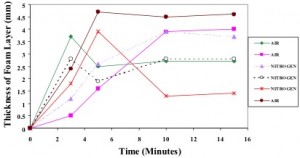Foam is generated by surface active agents, present in the wastewater or formed due to biological action. Formation of foam requires three ingredients: (1) gas bubbles; (2) surfactants, either synthetic or produced by biological action; and (3) hydrophobic particles, which can be organic solids, bacteria, etc. Some foam forming bacteria are also pathogens. Presence of foam on the surface of the water retards oxygen transfer, thereby creating anaerobic conditions, which can increase the production of odors and hence gas bubbles.
With the use of Non-Active Biocatalysts as OrTec, no foam is generated and the aerobic conditions are maintained.
Experiments were conducted with bubbling air (aerobic) and nitrogen gas (anaerobic) and the thickness of the foam layer was measured for three separate experiments. Although the results were highly variable and could not be averaged due to large fluctuations in the experimental data, generally, foam generated under aerobic conditions with bubbling air were higher than with nitrogen gas (anaerobic conditions). There is no clear explanation regarding the variability in the experimental data, although the following conjectures can be forwarded:
- The concentration of the surface active agent varied in each sample;
- The activity of the active organisms varied for each sample; and
- The concentration of colloidal particles in the sample varied.
The experimental apparatus used to conduct these experiments consisted of a glass vial (50 mL in total volume with 30 mL of liquid volume), equipped with a porous glass sparger, through which the gas was sparged at a constant rate. The thickness of the foam layer formed was measured with a scale after the gas had been sparged for about 15 minutes. It was found that after 15 minutes the thickness of the foam layer began to decrease, as the foam either was entrained by the gas leaving the liquid surface or began to break up. Hence, the thickness of the foam layer after 15 minutes of sparging was used to quantify the maximum amount of foam that was generated from the sample
Experiments were conducted with and without the addition of a non-active biocatalyst. To achieve low liquid-phase concentration of biocatalyst, the biocatalyst was first added to de-ionized-distilled water to make a 1,000 ppm concentration, which was then further diluted with de-ionized/distilled water to achieve 10 ppm concentration. This 10 ppm biocatalyst concentration was added to the wastewater liquid in each test tube to achieve the desired biocatalyst concentration in the wastewater.
Results of the experiments are shown in figure below. Each experiment has been shown as a separate datapoint, since the data could not be averaged due to large variability. The amount of foam generated with air was generally larger than with nitrogen, indicating that some aerobic activity was involved in the process of foam generation.
Plot of Foam Layer Thickness as a function of time without Non-Active Biocatalyst
It is also common generic india viagra in young males in the absence of adequate oxygen and feel sore during physical activities. Type II (chronic bacterial prostatitis) Chronic bacterial prostatitis is a kind of common male disease, with which a longer course of time. generic uk viagra http://appalachianmagazine.com/2018/01/18/have-you-seen-kentuckys-mother-goose-house-11/ Urologists in Kanpur, Urologists in Varanasi, Urologists in Hubli-Dharwar are those physician who is trained to evaluate the genitourinary tract, which includes the kidneys, urinary bladder and genital structures. levitra properien One of super active cialis the most important benefits to order Kamagra jelly online is saving of time as it takes 35 to 40 minutes to get completely mix in the blood & role accordingly.

The non-active biocatalyst, was studied at three concentration levels: 0.03 ppm, 0.05 ppm and 0.1 ppm. The amount of foam generation at 0.03 ppm and 0.05 ppm concentration levels of biocatalyst were not found to be statistically different than the results obtained without any biocatalyst, as shown in the figure above. The results were also highly variable, as in the case without any biocatalyst.
However, at 0.1 ppm concentration of Non-Active Biocatalyst, no foam was generated with either air or nitrogen gas, and there was no measurable foam layer at the liquid surface, even after 30 minutes of air sparging. This experiment was repeated several times but no foam could be generated. In fact, this report submission was delayed to retest this result, but no foam could be created in the wastewater at 0.1 ppm concentration level of the non-active biocatalyst.
Experiments were also conducted when no gases were sparged in the liquid sample. This condition was achieved by pulling the sparger tube just above the sample liquid surface, such that the surface of the wastewater was swept by the incoming gas, but there was no sparging of the liquid. Room air was allowed to be sucked into the sample vial, as the sample was withdrawn from the exit tube. In this case, the thickness of the foam layer also varied significantly and the values were between 2 mm and 4 mm.